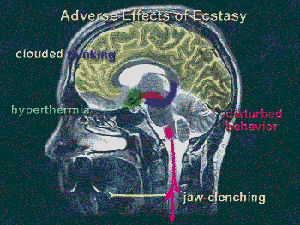Examples of Slides and Narrative Text in NIDA's New Teaching Packets
 "People who take ecstasy desire its pleasurable or reinforcing effects. However, few drugs are able to produce desirable effects without also producing side effects. Ecstasy is no exception, and there are several side effects or adverse effects that can occur, especially if the dose increases. Some people who take only one ecstasy pill may have negative psychological effects such as clouded thinking, agitation and disturbed behavior."
"People who take ecstasy desire its pleasurable or reinforcing effects. However, few drugs are able to produce desirable effects without also producing side effects. Ecstasy is no exception, and there are several side effects or adverse effects that can occur, especially if the dose increases. Some people who take only one ecstasy pill may have negative psychological effects such as clouded thinking, agitation and disturbed behavior." "Forget the stereotype of a drug addict hanging out on a dangerous street corner. Anyone can get hooked on drugs -- your friends, members of your family, your neighbors. Trying a drug just because a friend says it's 'cool,' might cost you much more than you bargained for.... Is it worth the risk?"
"Forget the stereotype of a drug addict hanging out on a dangerous street corner. Anyone can get hooked on drugs -- your friends, members of your family, your neighbors. Trying a drug just because a friend says it's 'cool,' might cost you much more than you bargained for.... Is it worth the risk?"NIDA has added a presentation that focuses on the risks of the club drug ecstasy (MDMA) and a presentation describing NIDA's science-based investigation of the causes and effects of drug abuse to its series of slide teaching packets, which are designed for use by health practitioners, teachers, and neuroscientists.
"The Neurobiology of Ecstasy (MDMA)," packet IV in the series, contains 20 color slides, an accompanying script, and guidance for creating a slide presentation. It describes MDMA's effects on the brain's serotonin pathway and the drug's short- and long-term adverse effects. The packet also includes a list of additional teaching resources and links to related Web pages, such as NIDA NOTES articles on ecstasy and NIDA's Web site on club drugs, www.clubdrugs.gov(discontinued).
Packet V incorporates NIDA's mission in its title, "Bringing the Power of Science To Bear on Drug Abuse and Addiction." The materials in this packet, which was designed primarily for use in middle schools, include 14 color slides illustrating how NIDA-supported research has led to an understanding of the effects of drugs and has been used to develop treatment and prevention programs. The packet also introduces the audience to NIDA's Web site as a resource for accurate drug abuse information.
All of the slide teaching packets include text that instructors can incorporate into a 30- to 40-minute presentation. The text can be used as a narrative "script" or can be customized for different audiences. The slide teaching packets are available for download from the web site. This NIDA site also includes guidance for creating slides from the downloaded files.
